If teeth are incorrectly aligned or the jaws are different lengths, the problem is referred to as a malocclusion.
There are a wide variety of malocclusions and not all cases require treatment. If a malocclusion is causing problems, treatment may be required. However, it would be considered unethical to correct a malocclusion for cosmetic purposes.
Some commonly seen malocclusions:
Mandibular brachygnathism
The mandible (lower jaw) is too short, in comparison to the maxilla (upper jaw), often resulting in the canine teeth (fangs) impingeing on the roof of the mouth. In puppies, the upper and lower jaws grow independently of one another, often at slightly different rates. When the lower canines dig into the palate (see picture), they create a dental interlock that can restrict the growth of the mandible, preventing it from reaching its full length. It is also painful for the puppy when the sharp deciduous teeth cause trauma to the palate. These teeth should be extracted at an early age, preventing discomfort and minimising the risk of the mandible remaining short. Some cases may require further treatment if a disparity in jaw length continues into adulthood. This defect is likely to have a genetic basis, so affected individuals should not be used for breeding.
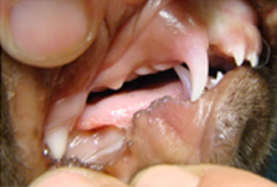
Lower canine teeth touching palate
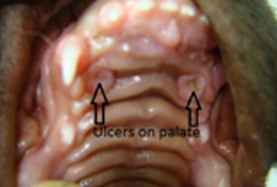
Ulceration in palate from lower canines
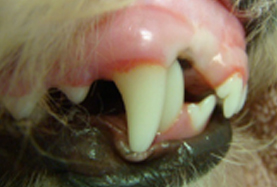
Lower canine position before treatment
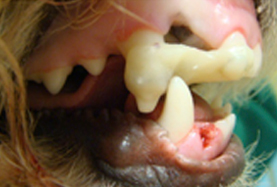
Incline plane device in position
Linguoverted lower canines
When the lower canine teeth tilt inwards, they often contact and cause trauma to the palate. This often occurs in conjunction with mandibular brachygnathism. Sometimes, the affected teeth can be moved using a specially designed incline plane device made of dental acrylic. This is usually kept in place for a few weeks before being removed. Occasionally, it is necessary to shorten the teeth. This will usually require some form of endodontic treatment (root canal treatment or vital pulp capping). Stone models made from impressions taken from the teeth can be invaluable for planning treatment and monitoring progress.

Incline plane device in position
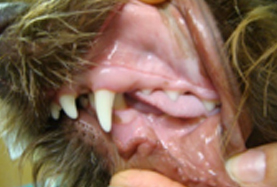
Lower canine digging into palate
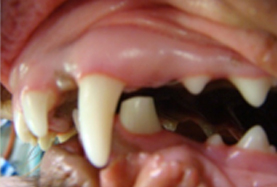
Shortened canine now clear of palate

Model of the above dog
